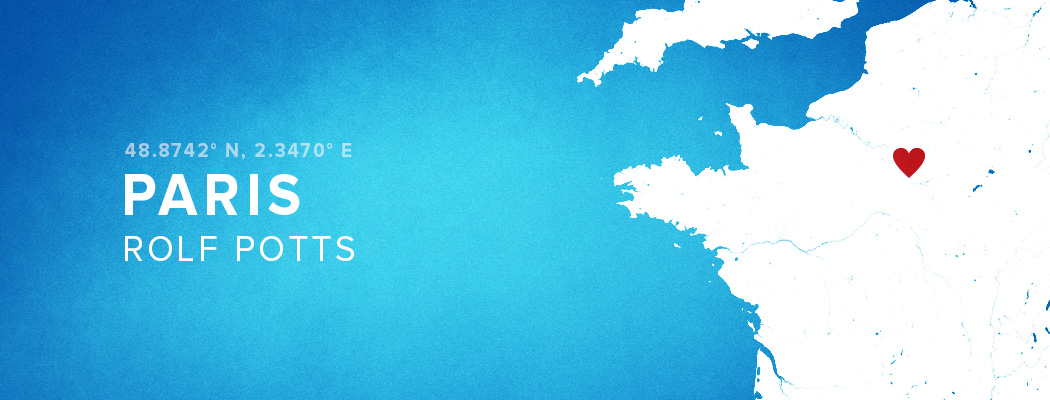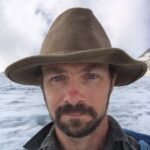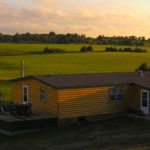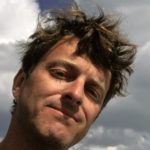Interview by Johnny Miller, Maptia.com
From bicycling across Burma, to shopping for donkeys in the Libyan Desert, to being drugged and robbed in Istanbul, to traversing Israel on foot… Rolf has had his fair share of epic adventures. He has dedicated most of his life to writing about experiences that communicate the glorious complexity and possibility of being alive. In his books, Rolf shares the spirit and philosophy of independent travel. Through the wonderfully voyeuristic ‘Marco Polo Didn’t Go There’ and the Zeitgeist defining ‘Vagabonding’, Rolf has inspired an entire generation (including us) to go out and see the world.
Rolf is one of the most thoughtful and eloquent writers of our generation, and we are honoured to have him here on the Latitude Series. In between his travelling stints, Rolf is also a lecturer at Yale University, and conducts writing workshops in Paris. We enjoyed chatting with him about the flâneurs of Paris and his various vagabonding adventures!
Hi Rolf. Wow, we’re thrilled to include you on our Latitude Series, so let’s get the ball rolling. You once confessed that after visiting places like Bangkok and Beijing (and Athens, and Jerusalem, and Damascus and Bombay), you were concerned that Paris might feel dull in comparison. Yet you now consider it to be the most beautiful city in the world. What was it about Paris that proved you so gloriously mistaken and captured your imagination, and was it a relationship that grew over time?
I think this was a classic case of misplaced expectations. This is something that happens to travelers time and again — and in fact one of the core challenges of travel is reconciling your expectations with what you really experience (and what is possible to experience) at a given place. I grew up with the impression that Paris was supposed to be this amazing, beautiful city, and I think there was a point at which I expected its reality to be less than its reputation. Unlike most American travelers, I didn’t begin my overseas travel career in Europe; instead I wandered (and lived in) Asia for three years before I crossed into Europe from the east, over the Ural Mountains. And even then I spent most of my time hitching around the eastern part of the continent; it was three more years until I’d made it west of Venice. By this time I was smitten by the splendor of big, chaotic eastern cities like Cairo and Bangkok and Varanasi. I expected Paris to be quaint and clean and faintly dull.
This was an anti-expectation — a reaction to prescribed notions of Paris — but it was still an expectation that, in the end, needed to be overturned. One day of walking through the city into the late July evening and I was in love with Paris. It was a city that matched its grand reputation for beauty, but in a quiet and unexpected and completely accessible way. It really is a city that needs to be experienced at a walking, wandering pace, and that is how I’ve deepened by relationship with the city over the years. I’ve walked hundreds of miles inside the city, rarely the same route twice. I always stay in an apartment at the edge of the 5th arrondissement, and I’m amazed by how I can stumble upon new things, even in my own corner of the city. I’ve always enjoyed the city as a flâneur, as a naïvist without a map, and I hope to continue to do so for years to come.
We love the idea of a flâneur being someone who seeks to explore and understand the nature of a city’s landscape by taking spontaneous and meandering adventures amidst the ebb and flow of life going on around them. It sounds like a delightful and very worthy way to spend time, whether travelling or at home. What do you think it is about the character and atmosphere of Paris that makes it such a fitting place for this kind of adventuring? Could you share with us a couple of your own flâneur-esque adventures you have had while wandering about the city?
It’s hard to envision the flâneur and not see Paris, since the city that gave rise to flânerie in the 19th century. Back then, Baudelaire noted that, when you become a flâneur, you “take up residence in multiplicity, in whatever is seething, moving, evanescent and infinite: you’re not at home, but you feel at home everywhere; you see everyone, you’re at the center of everything yet you remain hidden from everybody.” Paris is such an outdoor city to this day, so given to this public “multiplicity,” that it feels like the natural place to explore in the manner of a flâneur.
Some of my most enjoyable flâneur adventures have happened along the one-mile axis that separates rue Poliveau from rue St. Jacques (my apartment’s street to the street where I teach) in Paris. I decided many years ago that I would walk this distance using as many different routes as possible. Being accustomed to the American Midwest, with its grid-like street-patterns, I figured it would be just a matter of time before I’d systematically covered every possible path from home to school. There have indeed been times when I’ve thought I’d covered all the routes between Poliveau and St. Jacques — and these are the very moments when I’ve had the most delightful surprises. About six or seven summers into this experiment, I meandered off rue Monge and stumbled into the remains of the Arènes de Lutèce, a first-century Gallo-Roman amphitheater that lies about 800 meters from my front door. Had I explored my own neighborhood with guidebook in hand it would have been one of the first places I stopped; instead, as a flâneur, I had the joy of discovering it by accident, this fascinating relic of history in a neighborhood I thought I’d already known. I think about the Arènes de Lutèce whenever I get comfortable in a new city and start to feel a tad jaded. Sometimes the most amazing surprises of a place aren’t in some obscure corner of the city; they’re just around the corner, waiting for you to slow down, linger longer, meander off the most obvious route, and find them.
Delving briefly into Wikipedia, we found a long list of 144 novels and 376 films that are set in the evocative French capital. Over the years the city has become a vortex of emotion, as people find pleasure in the beauty of the city or in the atmosphere, or simply in the delightful ‘je ne sais quoi’ that somehow permeates much of how people experience the city. Many of them have only visited the city in their imaginations and have been transported there through the stories they have seen or read. Ranging from the beautifully animated film ‘Hugo’, set in the 1930s, to the delightfully quirky ‘Amélie’, generations of writers, poets, songwriters and filmmakers have created their own representation of the French capital. When you picture Paris in your minds eye, which artistic representation resonates with you the most? A song? A film? Or perhaps a book or a poem? And, just for fun, if you could be transported into the setting for any film or book set in Paris, where would you go?
This is an interesting question, because again it brings us into the realm of expectations versus lived experience — and into the ways in which fantasy and reality mix together. Before I went to Paris for the first time, my impressions of the city were a mish-mash of influences, from Amélie‘s fanciful Montmartre, to Hemingway’s American-tinged Latin Quarter, to the tourist-zone clichés that lay somewhere between Roland Barthes’ “Eiffel Tower” and National Lampoon’s European Vacation. To my delight, I found traces of all these influences as I wandered through the city. This affirmation of expectations is a time-honored travel ritual, and the more you experience a city, the more these received impressions mix with the actual textures of the city. Now, for example, a Carlos Gardel tune evokes the Paris of my imagination as vividly as any Edith Piaf song — in large part because I’ve spent so many summer evenings watching Parisians dance tango along the Left Bank of the Seine. For most people Gardel’s music evokes romanticized visions of Buenos Aires, but, after ten summers in Paris, I can’t hear a tango without envisioning dancers moving so gracefully in the little riverside amphitheaters below the Quai Saint-Bernard.
Were I to be transported into any film or book set in Paris, I’d probably go for Midnight in Paris. I realize that this is kind of a corny movie, but that’s part of its appeal, since it is precisely about the Paris of the imagination. To me, it feels like any depiction of Paris that is rooted in realism (even romanticized realism, like Before Sunset) doesn’t have that much to offer beyond what one could find by wandering the city’s streets on one’s own. The legendary “Lost Generation” experiences of American expatriates in the 1920s, for example, were probably pretty normal on a day-to-day level — and veterans of that scene have implied as much in their memoirs. Midnight in Paris, on the other hand, depicts a fantastical city, where Fitzgerald and Hemingway and Stein take specific interest in the romantic interloper and guide his experience of their Paris. In real-life most of us would be too shy and star-struck to mix in with that scene; in Woody Allen’s vision, those literary luminaries do the work for us; they are our own personal tour guides, not just of a city, but of an era.
You once wrote that, ‘vagabonding begins the moment you stop making excuses, start saving money, and begin to look at maps with the narcotic tingle of possibility.’ As someone who has travelled quite literally, all over the map, does cartography still inspire you and do maps still hold the same allure they once did when you first set out to explore the world in your twenties?
Maps very much remain a part of my travel imagination. In the functional sense, I use paper maps less often than I used to, especially in the industrialized world, where smartphones and GPS are a more efficient and interactive way of getting around. Still an electronic map just doesn’t cut it when it comes to daydreaming about travel. When I’m in this mindset, I don’t want to zoom in and out or be reminded of projected transit times or restaurant options; I just want to revel in the abstract possibilities of a place. I feel the same way when I’m recalling my travels: For some reason, a wrinkled paper map is far more evocative of my past travel experiences than an interactive display screen. Even in doing interviews like this, I sometimes jog my memory but jumping up and looking at the maps on my wall.
A younger generation of travelers might well come to see paper maps as a clumsy tool of an earlier age, kind of like a sextant or a steam engine — but I hope I never become fully dependent on electronic guidance systems, even in the functional task of finding my way around certain unfamiliar places. There’s something about paper maps that involve active effort and imagination, a process of filling in the blanks with your own imperfect perceptions. I don’t want to lose that.
Hearing stories told by a seasoned vagabonder such as yourself can be a little intimidating, as well as inspiring, for those who have yet to step outside of their comfort zone and embrace the vagabonding way of life. However, you like to say that, ‘everyone starts out as a vagabonding greenhorn’. Can you tell us about a couple of your greatest misadventures from your early vagabonding days?
I don’t need to recall my earliest vagabonding days to think of misadventures, since misadventures are an ongoing byproduct of interacting with unfamiliar places. Sure, you get more experienced the more you travel, and your instincts for vagabonding life improve, but I think the moment you stop having misadventures is the moment when you’ve stopped challenging yourself as a traveler. The reason I reassure readers that everyone starts as a “vagabonding greenhorn” is that too many beginning travelers are fixated on “doing things right,” on not looking foolish, when in fact travel doesn’t get interesting until you risk failure and embarrassment. This holds even more true ten years after I wrote the book, since the Internet and social media has made it easy for even backpackers to micromanage all the uncertainty out of a journey. By this standard of over-planning, a journey supposedly gets troublesome when it stops going according to plan. To the contrary, I believe journeys truly begin when they outgrow the original itinerary and veer into new directions.
So to this day I still find myself in misadventures. A couple of months ago, when I was in Tasmania, I got myself spectacularly lost for a couple of hours while flâneuring my way around the city of Hobart. I didn’t stumble my way into any fabulous epiphanies, but I did stumble my way into a few working-class bars, far from the sightseeing trail, and this afforded me a charming new perspective no the city. Well into my vagabonding career I’ve fallen for money-exchange scams in places like Havana and Santiago de Chile. I was shorted a few pesos in the process, but these encounters at the fringes of the local underworld helped me understand how creative and complicated the tourist economy can be. One of my favorite misadventures in recent years came when I was traveling across North Africa during my no-baggage journey around the world. Somehow, my cameraman and I miscommunicated our intention to go to the mountain town of Chefchaouen, and the taxi took us to Tetuan near the Mediterranean Sea — 65 miles away from our intended destination. Instead of stressing out, we just threw ourselves into the experience of this unexpected destination. As it turned out it was market day in Tetuan, and — with no bags to weigh us down — we had a fascinating time there.
With any luck, my vagabonding travels will continue to not always go according to plan. I’ve always said that one of these days some random Vagabonding reader is going to recognize me while I’m making a fool of myself in some exotic corner of the world. When that happens I’ll take comfort in the notion that I’m still finding ways to leave myself open to the unplanned moments that make travel interesting.
It seems like only yesterday our very first backpacking trips were coming to an end in various spots around the globe. Each of us remembers feeling somewhat apprehensive about transitioning back to ‘the real world’, especially after being temporarily disconnected from the familiar people and places we had grown up with. We imagine you are no stranger to the contrast of a life in which you are constantly moving and your senses are being bombarded with new places and new people and new things, versus a life in which you are engaging in more familiar pastimes along well-trodden paths. We were intrigued to hear that describe your home in Kansas as your ‘querencia’ and as the place where you go to renew and centre yourself. Can you elaborate on why you think this holds true and have you always felt this way about returning home? Has the concept of home changed over time for you?
Like flâneur, “querencia” is one of those words that doesn’t have a ready English equivalent. It essentially refers to the place where you feel most at home, the place where you are your most instinctive self, where you go to center yourself and rejuvenate. I’m originally from Kansas, but the fact that I found my querencia there is the culmination of ten years of wandering the earth. I love the heady energy and potential you feel when you’re constantly on the move, and I still feel that a month on the road has richer possibilities than a month at home. That said, there came a point when I realized that indefinite wandering would eventually yield diminishing returns unless I had a place to return to, a personally meaningful stretch of the planet where I could balance the experience of travel with the experience of stillness. For years I thought this place might be in some warm corner of Asia — but as much as I love Asia, I never quite found my querencia there.
One thing I did learn in Asia, however — something I learned everywhere I’ve been in the world, especially the developing world — is how important people regard family. In seeing how families drew strength and meaning from one another in distant corners of the globe, I began to reconsider the importance of my own family. Around this time my sister and her family had moved to a rural part of north-central Kansas, and she suggested I invest in some property and make my home base near her. Less than two miles from her place we noticed that 30 beautiful acres of grassland, complete with two houses, was for sale. I couldn’t afford it myself, so I went in on it with my parents, who had recently retired. They moved into the big new house, while I spent a year and a half renovating the doublewide as my own prairie office. Initially I think I saw this house as a place to linger between travels, but the more I invested in fixing it up, the more I spent time there, the more it began to feel like home on an intuitive level. Eight years on, that place has become as meaningful to me as my travels. The experience of vagabonding is something that deepens with experience, I think, and one way to give your travels added meaning over time is to cultivate some sense of home.
We sometimes find it hard to unplug from the ‘technological umbilical cord’, as you once described it, especially while we are building a new startup! On the other hand, the amazing proliferation of Internet access has enabled us to build Maptia from a Moroccan fishing village and we are immensely grateful for this freedom. You have written quite extensively about the complexities of travelling in a globalised world and of both the empowering benefits and stifling limitations of being permanently connected to the internet. So far, what has been the outcome of your own quest for online and offline equilibrium? Do you ever find that you can entirely ‘unplug’ from the white noise of the Internet?
It’s usually easier to identify the pitfalls of “connected” travel than it is to manage them. I’ve been writing about the dangers of over-connectedness since before the days of smartphones and social media, yet I often find myself indulging in the dull conveniences that come the “electronic umbilical cord.” I’ve been fairly disciplined about staying off of Twitter and Facebook while traveling overseas, for example, but the utility of Instapaper has proven hard to resist. Whereas in previous years I might have started each day by perusing magazines at a local newsstand, I now have reams of great reading material available through a simple smartphone app. Often these Instapaper readings are directly relevant to my travels — but reading on the road has never been purely about information, since the human resonance of chatting with the newsvendor or swapping papers with someone on the bus has always been half the fun of getting news locally. Moreover, having nothing to read in a far-flung locale can create the kind of boredom that leads to a heightened awareness of — and interaction with — the people and places around you.
Some of my best travel experiences have in fact been the direct result of boredom, loneliness, and inconvenience. The immediate gratification and psychic comforts that come with technology can thus detract from the hard-won joys of patient immersion in a place. Unplugging from the electronic umbilical can be a good way to re-immerse — but electronics are just the latest in a long line of technologies that have simplified travel. Should we also, in the interest of travel purity, shun jet planes, combustion engines, and paved roads? Should the true immersive traveler stop using maps and paper money? I don’t think so. But I do think vagabonders should be aware of the fact that convenience and efficiency don’t always make for novel or meaningful experiences on the road.
You currently teach non-fiction writing at Yale as well as hold workshops in Paris. We noticed that occasionally you like to conduct fun narrative experiments in your own writing, for example, using the second-person narrative. Thinking along those lines… the Maptia team would be delighted to hear one of Rolf’s most valuable nuggets of writing wisdom that he aims to pass on to his eager students.
Effective travel writing isn’t simply about recording what happened, or creating evocative descriptions, or sharing how you felt about a place. For a travel piece to work, you have to translate your own experiences into writing that guides the reader’s understanding of that place. You have to get reader’s attention, let her know what’s at stake, and offer her surprises and insights along the way. This is easy to imagine in principle, but it can be hard to do on the page. Thus, when I teach, I emphasize the importance of storytelling structure, and the necessity of strategic revision.
Reading widely, in multiple genres, is also key. This means immersing yourself in good writing that is not limited to nonfiction. One of my most popular travel stories, “The Art of Writing a Story about Walking Across Andorra,” was partly inspired by the second-person narrative voice in Lorrie Moore’s short-fiction collection Self-Help. My book Vagabonding owes a lot to the poetry of Walt Whitman. At Yale we emphasize “close-reading for craft” — encouraging students to read stories and essays not for content, but to discern the specific tactics and techniques writers use in constructing their narratives.
We have one last question to wrap up… you have said before that travelling is often a ‘matter of exploring half-understood desires’. Despite having traversed the globe and explored a myriad of amazing places, are you still filled with these desires, and where do you hope they might take you in the years to come.
The more time I spend away from Asia, particularly Southeast Asia, the more I long to return. I’d love to go back to a country I know well, like Thailand, and spend several months wandering out to countries I’m less familiar with, like Indonesia and Sri Lanka and Nepal.
I also harbor half-understood desires to explore sub-Saharan Africa. Sometimes this isn’t even a conscious longing; I’ll just suddenly find myself obsessing over books and articles about Namibia or Ethiopia or Mozambique, and I’ll realize that I’m preparing myself for something I can’t quite articulate yet — a journey that won’t make sense until I show up and start to wander.
[This interview originally appeared in Maptia on May 22, 2013]





